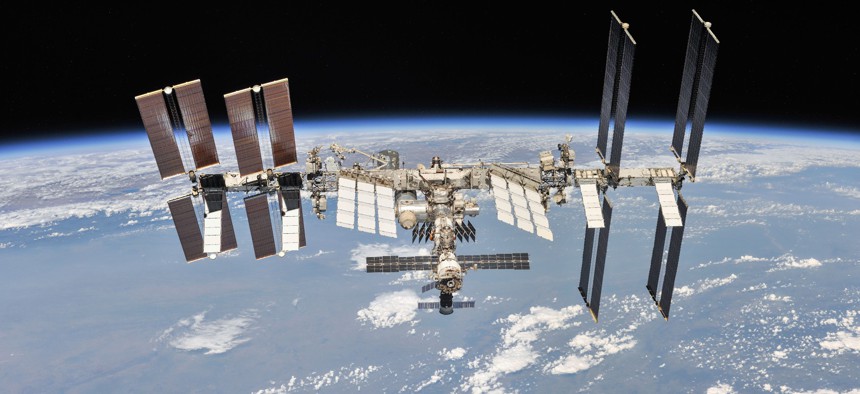Researchers Sent ‘Smart Fabric’ Capable of Detecting Microscopic Vibrations to Space

The International Space Station photographed by Expedition 56 crew members from a Soyuz spacecraft after undocking. Roscosmos/NASA
The acoustic fabric, which could eventually be used in spacesuits and soldier uniforms, “bridges the physical and digital domains,” officials say.
Army-funded researchers are testing the material stability of an ultra-sensitive smart fabric in space that could eventually be used in pressurized spacesuits to lend astronauts a sense of touch and to allow soldiers’ uniforms to measure their heart rates.
The acoustic fabric consists of vibration-sensitive fibers that convert mechanical vibration energy into electric energy, according to a Dec. 17 Army Combat Capabilities Development Command press release. Researchers from the Institute for Soldier Nanotechnologies, which includes the Army, the Massachusetts Institute of Technology and industry, partnered to develop the acoustic fabric.
Though the technology is still in the early stages of development, a year of testing on the International Space Station will show whether the fabric can hold up in the inhospitable Low Earth Orbit environment. Researchers sent a sample of the fabric to the ISS in November, where it has since been installed on an exterior wall. The sample should return in about nine months.
“Delivering revolutionary methodologies that result from foundational science is always one of our main priorities, and the opportunity to collect data from space dust using a fiber sensor as a key building block of the system is truly exciting,” Dr. James Burgess, ISN program manager for the Army Research Office, said in a statement. ARO is part of DEVCOM under the Army Research Laboratory.
While the fabric is being tested in space, ISN scientists on Earth will continue testing the sensitivity of the fabric for impact similar to those that would be caused by space dust. During tests at ground facilities, the fabric has been shown to detect and measure impact regardless of where dust impacted the surface of the fabric, according to the press release.
“Traditional telescopes use light to learn about distant objects; this fabric uses space dust analysis to learn about space,” Dr. Yoel Fink, professor of Materials Science and Electrical Engineering at MIT, said in a statement.
Juliana Cherston, the MIT graduate student leading the project, also found the acoustic fabric can accurately measure the impulse of small particles traveling at speeds of hundreds of meters per second.
Ultimately, the researchers see several applications for this technology. In addition to allowing astronauts to feel through their pressurized suits, acoustic fabrics could also be used in large areas on spacecraft, or in soldier uniforms to detect physiological measurements such as heart rate and respiration.
It could also be used for “generation and storage of energy” from a soldier’s uniform to power communications and sensors, like those that would be needed to detect radiologic, chemical and biological warfare agents, Burgess said. This could reduce the overall weight a soldier carries, he added.
Another application is for friendly identification: The fabric could be used to create clandestine beacon strobes so soldiers can differentiate friends from enemy combatants. It may also help with wound response technologies, Burgess said.
Work on smart-nano-fibers has been ongoing since 2007, Burgess told Nextgov in an email. This specific acoustic fabric project began “around 2018,” he added, and represents the culmination of a long-standing effort to draw fibers that link optical, mechanical and electric properties. If the material stability experiment goes well, Burgess said the next step is to try using the fabric to detect space dust on the ISS.
Despite this testing, Cherston stipulated the technology still has a long way to go before the potential applications are realized.
“It’s easy to assume that since we’re already sending these materials to space, the technology must be very mature,” Cherston said in a statement. “In reality, we are leveraging the space environment to complement our important ground-testing efforts. Our focus is on baselining their resiliency to the space environment.”




